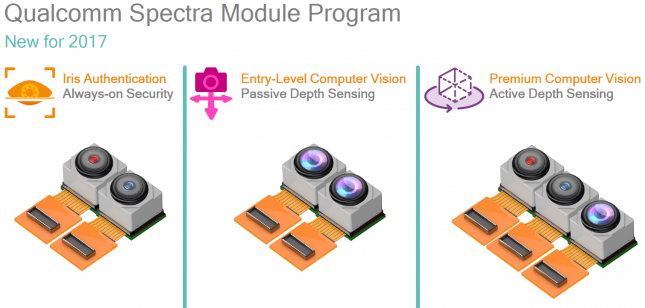Qualcomm’s Spectra Active Depth-Sensing Camera Coming Soon
Qualcomm has re-architected its Spectra Image Signal Processing (ISP) unit for the first time since it was introduced back in 2015 on the Snapdragon 820. Spectra was originally designed to increase the product-to-market time frames for customers of Qualcomm that wished to quickly and easily include camera technology in their device. Qualcomm touted that the original Spectra ISP had the processing capabilities to provide “DSLR-quality photography” in smartphones thanks to being able to capture 25 megapixel digital video at 30 fps and of course traditional photos.
The original Qualcomm Spectra technology was also important due to the fact that it supported dual-sensor cameras on a phone and this allowed Qualcomm to tap into the virtual reality market where there are an increasing number of mobile devices and head mounted displays (HMD) that must have good quality camera technology. This led to new devices like the Google Tango phones that took advantage of depth-sensing technology for augmented reality.
The need for improved biometric authentication and high-resolution depth sensing has never been higher and Qualcomm has been working to make improvements to the Qualcomm Spectra camera module that fast made it into consumer devices last year. Qualcomm successfully made easier and more cost effective for manufacturers to implement dual-sensor cameras in smartphones. Now, Qualcomm is taking it to the next level by offering three camera sensors to take advantage of active depth sensing. Depth sensing technology will allow for some pretty neat applications moving forward in the AR and VR markets.
The second-generation Qualcomm Spectra ISP family utilizes new hardware and software architecture designed specifically for advancements in computer vision, image quality, and power efficiency in future Snapdragon platforms. This technology will be placed on Qualcomm’s next SoC (the successor to the 835, which is likely the 836) due out near the end of the year if all goes as planned. The new Qualcomm Spectra camera module is capable of conservatively capturing 10,000 points of depth and with the highest resolution setting there is just 0.1mm in between each point. The range of the IR illuminator is approximately 3-4 meters. That allows Qualcomm to claim it has the most accurate depth-sensing technology on the market. Having precision is important when building a point cloud and is a must-have feature for smartphones here shortly.
“The introduction of our second generation Spectra ISP will advance computational photography, video recording and computer vision applications that require accurate motion tracking, all being processed efficiently on our digital signal processor (DSP).” Qualcomm said in a statement.
The 2nd Gen Qualcomm Spectra ISP also features multi-frame noise reduction for superior photographic quality, along with hardware-accelerated motion compensated temporal filtering (MCTF), and inline electronic image stabilization (EIS) for superior camcorder-like video quality.
We’ll close with the video above that shows off the new 2nd generation Qualcomm Spectra ISP camera module!





